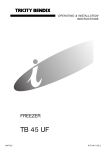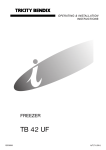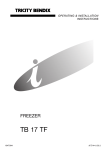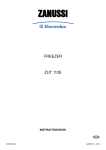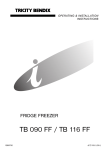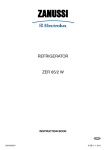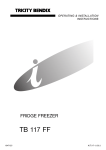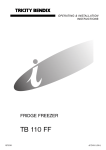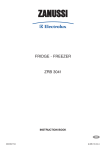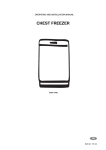Download Electrolux EU 1341 T User's Manual
Transcript
FREEZER INSTRUCTION BOOK EU 1341 T 200364703 A/E/13. (03.) This instruction book contains safety precautions, information on use and helpful hints and tips. To ensure you use this appliance effectively and safely, please read this instruction book carefully before installing or using this appliance and retain for future reference. The symbols below help you to find things more easily: Safety precautions Warnings and Safety information Hints, useful information Environmental information 2 IMPOR TANT S AFET Y INS TR UCTIONS These warnings are provided in the interests of your safety. Ensure that you understand them all before installing or using this appliance. Your safety is of paramount importance. If you are unsure about any of the meanings or these warnings contact Expert Appliance Care. Prior to installation Check the appliance for transport damage. Under no circumstances should a damaged appliance be installed. In the event of damage please contact your retailer. Installation This appliance is heavy. Care should be taken when moving it. It is dangerous to alter the specifications or attempt to modify this product in any way. Ensure that the appliance does not stand on the electrical supply cable. If the supply cable is damaged, it must be replaced by a cable available from Expert Appliance Care. Any electrical work required to install this appliance should be carried out by a qualified electrician or competent person. Parts which heat up should not be exposed. Whenever possible, the back of the appliance should be close to a wall, but leaving the required distance for ventilation, as stated in the installation instructions. The appliance should be left for 2 hours after installation before it is turned on, in order to allow the refrigerant to settle. Child Safety Do not allow children to tamper with the controls or play with the product. There is a risk of suffocation! Keep packaging material away from children! During Use This appliance is designed for domestic use only, specifically for the storage of edible foodstuffs. It is not intended for commercial or industrial use. Containers with flammable gases or liquids can leak at low temperatures. Do not store any containers with flammable materials, such as spray cans, fire extinguisher refill cartridges etc. in the freezer. Frozen food should not be refrozen once it has thawed out. Do not place carbonated or fizzy drinks in the freezer. Ice lollies can cause 'frost/freezer burns' if consumed straight from the freezer. Do not remove items from the freezer if your hands are damp/wet, as this could cause skin abrasions or frost/freezer burns. Bottles and cans must not be placed int the freezer they can burst when the contents freeze. Manufacturers' recommended storage times should be adhered to. Refer to relevant instructions. Maintenance and Cleaning Before cleaning, always switch off the appliance and disconnect from the electrical supply. When unplugging always pull the plug from the mains socket, do not pull on the cable. Servicing This product should be serviced by an authorised engineer and only genuine spare parts should be used. Under no circumstances should you attempt to repair the appliance yourself. Repairs carried out by inexperienced persons may cause injury or serious malfunctioning. Contact Expert Appliance Care. At the end of the Appliance Life When disposing of your appliance use an authorised disposal site. Remove the plug and ensure that any locks or catches are removed, to prevent young children being trapped inside. Safety precautions for isobutane Warning The refrigerant isobutane (R 600a) is contained within the refrigerant circuit of the appliance, a natural gas with a high level of environmental compatibility, which is nevertheless flammable. Keep ventilation openings, in the appliance enclosure or in the built-in structure, clear of obstruction. Do not use mechanical devices or other means to accelerate the defrosting process, other than those recommended by the manufacturer. Do not damage the refrigerant circuit. Do not use electrical appliances inside the food storage compartments of the appliance. The Appliance and the Environment This appliance does not contain gases which could damage the ozone layer. Avoid damaging the cooling unit. The packaging used on this appliance marked with the symbol is recyclable. Keep this instruction book for future reference and ensure it is passed on to any new owner. 3 CONTENT S Instructions for the User Instructions for the Installer Guide to use the instruction book 2 Technical Specifications 12 Important Safety Information 3 Instructions for the User General Information Description of the Appliance 5 5 5 Installing the Appliance Transportation, Unpacking Location Ventilation Requirements Levelling 12 12 12 13 13 Indicator Lights Fast Freeze Facility Basket Storage Freezer Tray 6 6 6 6 Door Reversal 13 Electrical Connection 15 Using the Appliance Before Use To Start the Appliance Thermostat Control Freezing Fresh Food Frozen Food Storage Thawing Making Ice Cubes 7 7 7 7 7 8 8 8 Hints and Tips Food Storage Energy Saving Advice In the Event of a Power Failure 8 8 9 9 Maintenance and Cleaning Internal cleaning External cleaning When the appliance is not in use Defrosting 10 10 10 10 10 Something Not Working 11 Service and Spare Parts 11 4 INS TR UCTIONS FOR THE USER General information This appliance is designed for the freezing and storage of frozen food in a domestic home. To ensure correct operation, the appliance should be located where the ambient temperature is between 16-32 °C. Description of the Appliance 1. Freezing tray (with 1 ice trays) 6. Defrost water outlet 2. Freezing compartment 7. Adjustable feet 3. Storing compartments (wire baskets) 8. Door gasket 4. Rating Plate 9. Thermostat 5. Control Panel 10. Air grid a) Green Indicator Light 11. Condenser b) Red Indicator Light 12. Air circulation c) Yellow Indicator Light 13. Compressor d) Fast Freeze Switch (continuous operation) e) Thermostat control knob 5 Indicator Lights The indicator lights are situated in the control panel. a.) Green Indicator Light When the appliance is switched on at the mains the green indicator light will illuminate and remain lit until the appliance is switched off at the mains. b.) Red Indicator Light A few hours after starting up the red indicator light will go out to show that the correct temperature has been reached for the setting chosen and will stay out to indicate that everything is in order. It will come on if the freezer temperature rises unduly for instance, after opening the freezer door or placing food inside the cabinet, but the light should go out again when the temperature returns to the correct storage level. c.) Yellow Indicator Light - (Fast Freeze) When fast freeze is switched on the yellow indicator light will illuminate and remain lit until fast freeze is switched off. d.) Fast Freeze Facility To operate the fast freeze facility slide the switch to the right hand position. e.) Thermostat Control This is for setting and changing the temperature inside the appliance. Basket Storage Frozen food should be stored in the two lower baskets and the top compartment used for fast freezing. Freezer Tray The freezer tray is particularly suitable for open freezing, for example strawberries, raspberries etc. 6 Using the Appliance Before Use Remove all packaging and securing tapes. Wash inside the appliance with lukewarm water and bicarbonate of soda (5 ml to 0,5 litre of water). Do not use soap or detergent as the smell may linger. Dry thoroughly. Do not use detergents, abrasive powders, highly perfumed cleaning products, wax polishes or products containing alcohol. F To Start the Appliance 1. Allow the appliance to stand for 2 hrs after installation. 2. Plug in the appliance and switch on at the mains supply. 3. Slide the 'fast freeze' switch to the right (yellow indicator light will illuminate) and leave to run for 4 hours to allow the correct temperature to be reached before placing food inside. 4. The red indicator light will also illuminate until the correct temperature is reached. 5. When the appliance has reached the set temperature and the red indicator light has gone out slide the 'fast freeze' switch back to the left. Thermostat Control The temperature within the freezer is controlled by the thermostat control knob situated on the control panel. 0 = Off Turning the thermostat control knob clockwise makes the temperature progressively colder. Freezing Fresh Food It is important that fresh food placed in the freezer is frozen quickly and that the food already in the freezer is heated as little as possible. F If more than 3-4 kg of food is to be frozen: 1. Slide the fast freeze switch (d) to the right 6-24 hours before placing the fresh food in the freezer, the yellow light will illuminate. The compressor will now run continuously, to ensure that the fresh food is frozen as quickly as possible. 2. Place the food in the freezing compartment and leave the 'fast freeze' switch on for a further 24 hours. 7 3. After 24 hours, slide the 'fast freeze' switch back to the left (the yellow light will go out) and transfer the food to the storing compartments. The freezer will return to normal storage temperature. If the 'fast freeze' switch is accidentally left on, the freezer will not be damaged, but energy will be wasted. Frozen Food Storage When first starting the freezer or if the freezer has been out of use for some time, we advise you to run your appliance for at least 2 hours with the 'fast freeze' switch on before storing frozen food. Do not exceed the storage period indicated by the manufacturer. Do not open the door frequently or leave it open longer than is necessary. Important Do not put carbonated liquids in the freezer. Ice lollies, if consumed immediately after removal from the freezer can cause a low temperature skin burn. Do not remove items from the freezer if your hands are damp/wet, as this could cause skin abrasions or frost/freezer burns. In the event of a power cut the food in the freezer will not be affected if the power cut is short and the freezer is full. Do not open the lid. Should the food begin to thaw it must be consumed quickly and must not be re-frozen. (See Hints and Tips) Thawing Deep frozen or frozen food, prior to being used, can be thawed in a fridge or at room temperature, depending on the time available. Small food items may even be cooked from frozen, in this case cooking will take longer. Any frozen food which is allowed to thaw accidentally should either be eaten as soon as possible, or thrown away. Alternatively, if the food is uncooked and has not been completely defrosted it can be cooked and then refrozen. Defrosted cooked food must never be refrozen. 8 F To Make Ice Cubes 1. Fill the ice cube tray 3/4 full with cold water, place in the freezing compartment and leave to freeze. 2. To remove the cubes twist the tray or hold it under running water for a few seconds. Never try to free an ice tray that is frozen to the freezer compartment by using pointed or sharp edged objects. Hints & Tips Food Storage To obtain the best performance from your freezer: Do not store warm food or evaporating liquid. Avoid buying frozen food if you cannot store it straight away. The use of an insulated container is advisable. When you arrive home, place the frozen food in the freezer immediately. Do not push food together too much, try to allow air to circulate around each item. Do not store food uncovered. Ensure that food placed in the freezer is dated and labelled and used in date order to ensure that food is consumed at its best. Lean food keeps better and longer than fatty food, salt reduces the storage time. Wrap the food in polythene or aluminium freezing bags or foil so that they adhere to the food and provide an airtight seal. Packaging which is swollen or has traces of refrozen water droplets on the pack could indicate that the product has not been kept at a suitable temperature and that it may have lost its original quality. Partially thawed food must not be refrozen, it must be consumed within 24 hours. Never exceed the storage times indicated by the manufacturer. Energy Saving Advice Do not install the appliance close to sources of heat, such as a boiler or radiator. Locate the appliance in a cool well ventilated room and make sure that the air openings of the appliance are not obstructed. Avoid unnecessary frosting in the cabinet by packing all foodstuffs into airtight packages before placing them in the freezer. Food which is to be frozen (when cool) should be placed in the fridge before being transferred to the freezer. Try to avoid keeping the door open for long periods or opening the door too frequently as warm air will enter the cabinet and cause the compressor to switch on unnecessarily often. Ensure there are no obstructions preventing the door from closing properly. In the Event of a Power Failure If there is a power failure during the storage of frozen foods, keep the door closed. If the temperature within your freezer should rise, do not refreeze the food without checking its condition. The following guidelines should assist you: Ice Cream: Once thawed should be discarded. Fruits & Vegetables: If soft should be cooked and used up. Breads & Cakes: Can be refrozen without danger. Shellfish: Should be refrigerated and used up quickly. Cooked Dishes: i.e. casseroles should be refrigerated and used up. Large Pieces of Meat: Can be refrozen providing there are still ice crystals remaining within them. Small Joints: Should be cooked and can then be refrozen as cooked dishes. Chicken: Should also be cooked and refrozen as a fresh dish. 9 Maint enance & Cleaning Before any maintenance or cleaning is carried out you must DISCONNECT the appliance from the electricity supply. Internal Cleaning Clean the inside and accessories with warm water and bicarbonate of soda (5 ml to 0.5 litre of water). 2. Remove any stored food, wrap in several layers of newspaper and store in a cool place. 3. Leave the door open. 4. Carefully draw the plastic drain spout out of the lower part of the appliance according to the direction of the arrow and place a tray of a suitable size in the position shown. Rinse and dry thoroughly. NEVER use detergents, abrasive powders, highly perfumed cleaning products or wax polishes to clean the interior as these will damage the surface and leave a strong odour. External Cleaning Wash the outer cabinet with warm soapy water. Once or twice a year dust the condenser (black grille) and the compressor at the back of the appliance with a brush or vacuum cleaner, as an accumulation of dust will affect the performance of the appliance and cause excessive electricity consumption. When the Appliance is not in Use When the appliance is not in use for long periods, disconnect from the electricity supply, empty all foods and clean the appliance, leaving the door open to prevent unpleasant smells. 5. During defrosting, push the defrost water towards the edge of the cooling plates using a dry cloth or a sponge. It will be collected at the bottom of the appliance, from where it can be diverted into the tray and then disposed of. 6. To accelerate the defrosting process place a bowl of hot (not boiling) water inside the freezer and close the door. Defrosting 7. When defrosting is completed, dry the interior thoroughly, replace the drain spout and close the door. The freezer compartment will become progressively covered with frost. This should be removed with the special plastic scraper provided whenever the thickness of frost exceeds 6 mm (1/4). 9. Replace the previously removed food. During this operation it is not necessary to switch off the power supply or to remove the foodstuffs. However, when the ice becomes very thick on the inner liner, complete defrosting should be carried out and it is advisable to peform this operation when the appliance is empty. F To carry out complete defrosting: 1. Disconnect the appliance from the electrical supply. If the plug is inaccessible turn the thermostat control knob to 0. 10 8. Turn the thermostat control knob back to a medium setting and leave to run for at least 4 hours with the 'fast freeze' switch on. Important A temperature rise of the frozen food packs during defrosting may shorten their safe storage life. Never use sharp metal tools to scrape off frost from the evaporator as this could damage the appliance beyond repair. Something Not Working If the appliance is not working correctly, please carry out the following checks before contacting Expert Appliance Care. Problem No power to the appliance The temperature in the appliance is too high Possible Cause No power at the socket. There is a power cut. The fuse has blown. Thermostat control knob is set at 0. The appliance is located in an unsuitable position. The thermostat control is set too low. The temperature in the appliance is too low Excessive frost and ice has built up The appliance is noisy. The thermostat control knob is set too high. The door has been left open. Something is obstructing the door. The door gasket is dirty. The appliance is not level. If after the above checks your appliance still does not operate correctly, contact Expert Appliance Care. Please note that it will be necessary to provide proof of purchase for any in-guarantee service calls. Solution Check there is power at the socket. Check there is not a power cut by checking the household lights. Check the fuse has not blown. Check the thermostat control knob setting. Check the ambient temperature is within the appliances operating limits of 16 °C to 32 °C. Check that the thermostat control knob is turned to the correct setting relative to ambient conditions. Set the thermostat control knob to a lower position. Check the door has not been left open. Check nothing is preventing the door from closing. Check the door gasket is intact and clean. Check if the appliance stands stable (all four feet should be on the floor). In-guarantee customers should ensure that the above checks have been made, as the engineer will make a charge if the fault is not a mechanical or electrical breakdown. Ser vice and Spar e P ar ts If you require further information regarding the appliance, the terms and conditions of the guarantie, or wish to call out an engineer, please contact Expert Appliance Care by telephoning: 0870 9099100 11 Ins tr uctions f or the Ins t aller Technical Specifications Model Gross capacity (l) Net capacity (l) Width (mm) Height (mm) Depth (mm) Energy consumption (kWh/day) (kWh/year) Energy class, according to EU Standards Freezing capacity (kg/24h) Rising time (h) Rated power (W) Weight (kg) EU 1341 T 117 100 550 850 600 0.56 204 A 12 17 90 39 Installing the appliance Location Transportation, unpacking The appliance should be positioned in a well ventilated, dry room. The appliance and the interior fitting are protected for transport. Remove all packaging and any adhesive tape. Any remnants of adhesive can be removed using white spirit. After transportation the appliance must not be switched on for 2 hours. This is to allow the refrigerant to settle. Cleaning Clean the accessories and the inside of the appliance with warm water and bicarbonate of soda (5 ml to 0.5 litres of water). Rinse and dry thoroughly. Do not use detergents, abrasive powders, highly perfumed cleaning products, wax polishes or cleaning products containing bleach or alcohol. 12 Energy use is affected by the ambient temperature. The appliance should therefore: not be installed next to radiators, cookers or other sources of heat only be installed at a location where the ambient temperature corresponds to the climate classification, for which the appliance is designed. The climate classification can be found on the rating plate. The following table shows which ambient temperature is correct for each climate classification: Climate Classification Ambient Temperature SN +10 to +32 °C N +16 to +32 °C ST +18 to +38 °C Ventilation Requirements The appliance must have adequate ventilation to ensure correct operation. Diagram shows the ventilation requirements when installed: A* Under a worktop, or cupboard. * The clearance space of 10 cm above the appliance may be reduced to 5 cm providing a clearance space 2.5 cm is left on either side of the appliance. B When freestanding Levelling The appliance must be level. Level the appliance by adjusting the two adjustable feet (1) at the front of the appliance. If required the washer (2) can be removed. Door Reversal If required the opening direction of the door can be changed as follows: Disconnect the appliance from the electricity supply. Tilt the appliance backwards, resting the top edge of the appliance on a stool or something similar. Unscrew the adjustable feet situated on both sides at the front (2 pieces). Remove the lower door hinge plate by unscrewing the 3 retaining screws. Remove the hinge pin from the bottom of the door. Slot the hinge pin into the hole in the hinge plate. Take the door off. 13 Refit the upper hinge pin into the opposite location. Fit the door in place on the hinge pin. Slot the hinge pin into the hole in the hinge plate and relocate the hinge assembly to the opposite location and refit using the retaining screws. Refit the bottom hinge plate assembly on the opposite side, taking care that the edge of the door is parallel with the side of the cabinet. To reverse the handle proceed as follows: Remove screw covers (if fitted) and handle retaining screws. Remove blanking plugs on the opposite side. Relocate the handle to the opposite side and refit retaining screws (covers if fitted), and replace the blanking plugs. 14 Electrical Connection Any electrical work required to install this appliance should be carried out by a qualified electrician or competent person. This appliance must be earthed. The manufacturer declines any liability should these safety measures not be observed. Electrical Requirements Before switching on, make sure the electricity supply voltage is the same as that indicated on the appliance rating plate. The appliance is supplied with a 13 amp plug fitted. In the event of having to change the fuse in the plug supplied, a 13 amp ASTA approved (BS 1362) fuse must be used. Should the plug need to be replaced for any reason. The wires in the mains lead are coloured in accordance with the following code: Green and Yellow: Earth Blue: Neutral Brown: Live The wire coloured green and yellow must be connected to the terminal marked with the letter E or by the earth symbol or coloured green and yellow. The wire coloured blue must be connected to the terminal N or coloured black. The wire coloured brown must be connected to the terminal marked L or coloured red. Upon completion there must be no cut, or stray strands of wire present and the cord clamp must be secure over the outer sheath. This appliance complies with the following E.E.C. Directives: 73/23 EEC of 19.02.73 (Low Voltage Directive) and subsequent modifications, 89/336 EEC of 03.05.89 (Electromagnetic Compatibility Directive) and subsequent modifications. 15 2003. 03. 26. The Electrolux Group is the world's largest producer of powered appliances for kitchen, cleaning and outdoor use. More than 55 million Electrolux Group products (such as refrigerators, cookers, washing machines, vacuum cleaners, chain saws and lawn mowers) are sold each year to a value of approx. USD 14 billion in more than 150 countries around the world. © Electrolux plc 2003 Printed by Xerox Hungary Ltd. The Electrolux Group. The worlds No.1 choice.
















